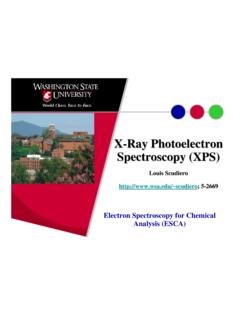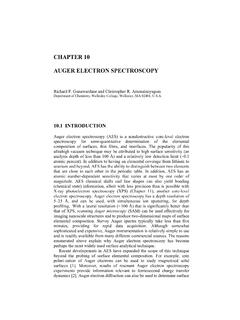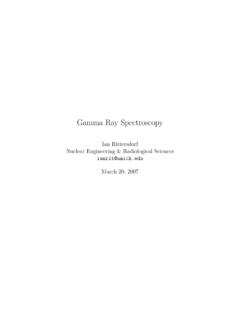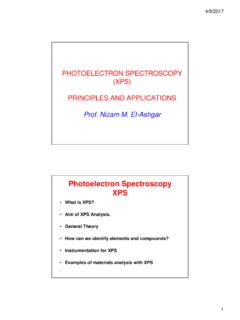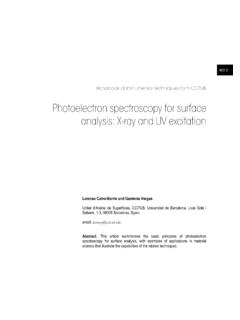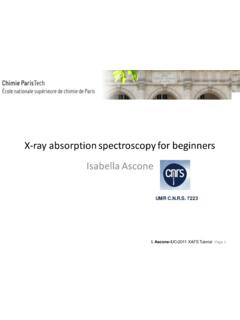Transcription of Introduction to X-ray Photoelectron Spectroscopy (XPS)
1 Introduction to X-ray Photoelectron Spectroscopy (XPS) XX--ray Photoelectron Spectroscopy (XPS), also ray Photoelectron Spectroscopy (XPS), also known as Electron Spectroscopy for Chemical known as Electron Spectroscopy for Chemical Analysis (ESCA) is a widely used technique to Analysis (ESCA) is a widely used technique to investigate the chemical composition of the chemical composition of surfaces. XPS which makes use of the photoelectric effect, XPS which makes use of the photoelectric effect, was developed in the midwas developed in the mid--19601960 s by Kai s by Kai SiegbahnSiegbahnand his research group at the University of and his research group at the University of Uppsala, , of ElectronsConduction BandConduction BandValence BandValence BandL2,L3L2,L3L1L1 KKFermi LevelFermi LevelFree Electron Level (vacuum)Free Electron Level (vacuum)
2 Incident XIncident X--rayrayEjected PhotoelectronEjected Photoelectron1s1s2s2s2p2p XPS spectral lines are identified by the shell from which the electron was ejected (1s, 2s, 2p, etc.). The ejected Photoelectron has kinetic energy: KE= hv BE - Following this process, the atom will release energy by the emission of a photon or Auger Electron EmissionConduction BandConduction BandValence BandValence BandL2,L3L2,L3L1L1 KKFermi Fermi LevelLevelFree Free Electron Electron LevelLevel1s1s2s2s2p2pConduction BandConduction BandValence BandValence Band1s1s2s2s2p2p L electron falls to fill core level vacancy (step 1).
3 L electron falls to fill core level vacancy (step 1). KLL Auger electron emitted to conserve energy released in step 1 KLL Auger electron emitted to conserve energy released in step The kinetic energy of the emitted Auger electron is: The kinetic energy of the emitted Auger electron is: KE=E(K)KE=E(K)--E(L2)E(L2)--E(L3).E(L3). XPS Energy Scale - Binding energyBE = BE = hvhv--KE KE -- specspecWhere: Where: BE= Electron Binding EnergyBE= Electron Binding EnergyKE= Electron Kinetic EnergyKE= Electron Kinetic Energy specspec= Spectrometer Work Function= Spectrometer Work FunctionPhotoelectron line energies: Photoelectron line energies: Not DependentNot Dependenton photon photon electron line energies: Auger electron line energies.
4 DependentDependenton photon photon spectrum of VanadiumAuger electronsNote the stepped background Only electrons close to surface can escape elastically ( 63%, 3 95%)) Electrons from deeper in sample undergo inelastic collisions while traveling to the surface giving rise to the stepped background Empirical models can be used to subtract the backgorundX-ray Photoelectron SpectrometerXX--rayraySourceSourceElectr onElectronOpticsOpticsHemispherical Energy AnalyzerHemispherical Energy AnalyzerPosition Sensitive Position Sensitive Detector (PSD)Detector (PSD)Magnetic ShieldShieldOuter SphereOuter SphereInner SphereInner SphereSampleSampleComputer Computer SystemSystemAnalyzer ControlAnalyzer ControlMultiMulti--Channel Plate Channel Plate Electron MultiplierElectron MultiplierResistive Anode Resistive Anode EncoderEncoderLenses for Energy Lenses for Energy Adjustment Adjustment (Retardation)(Retardation)Lenses for Analysis Lenses for Analysis Area DefinitionArea DefinitionPosition ComputerPosition ComputerPosition Address Position Address electron energy analyzerCylindrical mirror electron energy analyzerX-ray sourcee-X-rayswaterTungsten Filament~15,000 VoltsMg(K )
5 : h = eVAl(Ka) : h = eVNote that most XPS peaks appear as Energy (eV)Cu 2p2p1/22p3/2 Peak Area 1 Energy (eV)Cu 2p2p1/22p3/2 Peak Area 1:2 Electron quantum numbersorbital momentum: l= 0,1,2,3 (s, p, d, and f orbitals)spin momentum:s= + , - total momentum: j= l + sSince scan be + or - ,each level with l>0 is split into two sublevels with an energy difference known as the spin-orbit splitting. The degeneracy of each of these levels is 2j+1A little quantum mechanics is needed to understand why this is the caseOrbital lj degeneracyElectron level1s01/211s2s01/212s2p11/222p1/22p13/ 242p3/23d23/243d3/23d25/263d5/24f35/264f 5/24f37/284f7 Energy (eV)Cu 2p2p1/22p3/2 Peak Area 1:2 Orbital lj degeneracyElectron level2p11/222p1/22p13/242p3 Energy (eV)Peak Area 2:3Ag 3d3d3/23d5/2 Orbital lj degeneracyElectron level3d23/243d3/23d25/263d5 Energy (eV)Peak Area3:4Au 4f4f5/24f7/2 Orbital lj degeneracyElectron level4f35/264f5/24f37/284f7/2 What information can you obtain from XPS?
6 What information can you obtain from XPS? Identification of elements near the surface and surface composition Local chemical environments Oxidation states of transition metals Valence band electronic structure Morphology of thin filmsThe universal electron scattering curve Sampling Depth Electron mean free path is energy dependent Sampling depth is materials dependent XPS is surface sensitive but samples more than just the surface Electron Energy (eV)Mean Free Path, ( )Elemental ShiftsBinding Energy (eV)Element2p3/23p Fe70753654Co77860718Ni85367786Cu93375858 Zn102289933 Atomic NumberBinding Energy, eVElectron Binding EnergiesChemical ShiftsChemical Shifts In addition to the identity of the element and the orbital (s,p, d, f) electron binding energies depend on:(1) the formal oxidation state of the atom (2) the local chemical environment Both (1) or (2) cause small binding energy shifts (< 5 eV) An increase in oxidation state causes the binding energy to increase due to a decrease in the screening of the bound electron from the ion core.
7 The ability of XPS to determine oxidation states is used extensively in catalysis StatesVanadium foilV0V2O5V5+V(2p3/2)V0V+ eVO505515525535 Binding energy, eVO 1sV 2p3/2V 2p1/2 VOx/TiO2(110)500510520530540 Binding energy, eVdcbaV 2p1/2V 2p3/2 O 1s Binding energy, eV10-7 torr O2 Just deposited52552051051510-3 torr O2V 2p3 ML VOx-XPSVOx/CeO2(111)10-3torr O2400 K10-7torr O2575 KAs depositedClean eVV+ eVV+ eVV+ eVV 2p3/2 Chemical Shifts - Electronegativity EffectsLocal chemical environment can also cause small shifts in XPS peak positionsFunctionalGroupC(1s)Binding Energy(eV)hydrocarbonC-H, , etherC-O-H, bound to bound to substituents decrease the electron density on the carbon atom causing a small in crease in the C(1s) binding energyC-F + -XPS of Polyethylene-terephthalateOOCOCOCH2CH2nQ uantitative elemental analysisChemical state analysis1s1s2s2s2p2p3d3dh Primary photoemissionShake-up process1s1s2s2s2p2p3d3dh EKE = KE = hvhv--BE BE -- KE = KE = hvhv--BE BE -- -- EE 860880900920940 Binding energy, eVCe(3d)
8 - Ce+4u'''uv''v'v'''u''u'vPeaks Initial State Final StateCe4+v,u3d104f03d94f2Vn-2Ce4+v'',u'' 3d104f03d94f1Vn-1Ce4+v''',u''' 3d104f03d94f0 VnFinal State Effects - Shake-up featuresShakeShake--up features occur when additional electron energy level transitiup features occur when additional electron energy level transitions occur ons occur during the Photoelectron emission processduring the Photoelectron emission processQuantitative Analysis of XPS DATAQ uantitative Analysis of XPS DATAFor a homogenous sample:Element sensitivity factorsSensitivity factor = S = f D f = X-ray fluxs = Photoelectron cross-sectionD = detector efficiency =electron mean free pathn1n2I1/S1I2/S2=ni= number of I atomsIi= area of I photoemission peakS = sensitivity factor for inxIx/Sx ni Ii/Si=iiCx= concentration of element xCx= Relative Sensitivities of the Elements024681012 Elemental SymbolRelative SensitivityLiBeBCNOFNeNaMAlSiPSClArKCaSc TiVCrMFeCoNiCuZnGGAsSeBrKrRbSrYZrNbMTcRu RhPdAgCdInSnSbTeIXeCsBaLaCePrNdPSEuGTbDy HoErTYbLuHfTaWReOsIrPtAuHgTlPbBi1s2p3d4d 4fS(F1s)
9 = energy, eV0204060800246Ce 3d/ V 2p3/2 intensity ML of vanadium depositedML of V 1sV 2p1/2V 2p3/2 Vanadium Deposition on CeO2(111)Layer-by-layer film growthV+3 XPSCeO2(111)V 2p3/2= eVThin Film MorphologyThin Film MorphologyXPS Depth ProfilingAr+ion sourceSputtering timeXPS depth profile of SiO2layer on silicon waferSi(2p) - eVSi4+(2p) - eVScanning XPS- Provides elemental and chemical state maps of surfacesUse electrostatic lenses to select which are of the surface is analyzedRaster the X-ray the electron beam in the X-ray source to be rasteredand a complex quartz crystal lens to focus the x-rays.
10 XPS image of a patterned polymer filmimageline scanXPS of Supported CatalystsXPS of Supported CatalystsIssues: Sample is not homogenous Only analyze external surface Sample charging Beam damageValence Band Photoelectron SpectroscopyValence Band Photoelectron Spectroscopy Density of states near the Fermi level. Electronic states in the band gap Binding energies of valance electrons of adsorbatesNeed very high energy resolution to obtain useful information. He discharge lamp or synchrotron is typically used as the photon sourceIf ultraviolet photons (rather than x-rays) are used the technique is called Ultraviolet Photoelectron Spectroscopy (UPS).
